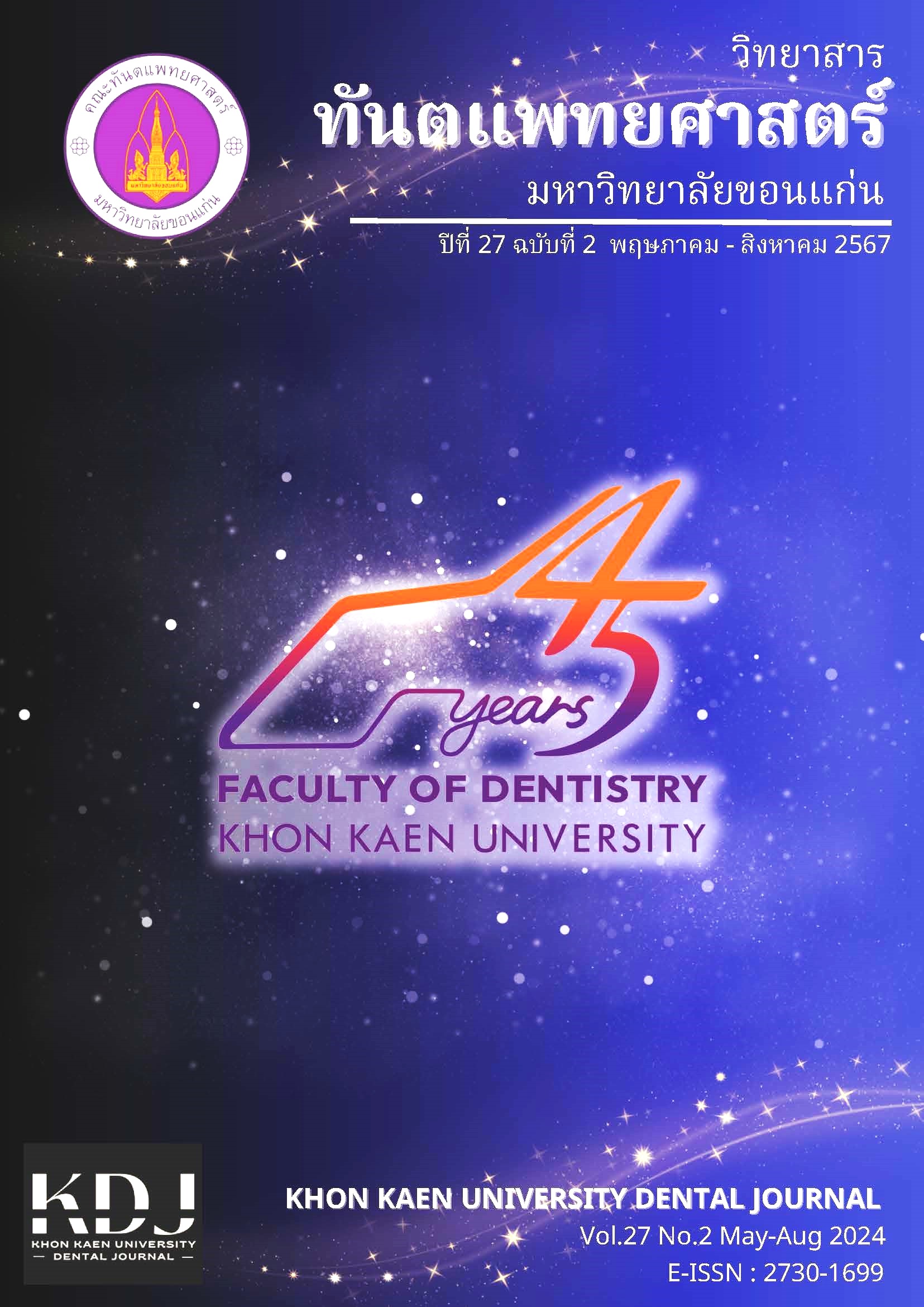The Penetrating Ability of Elastomeric Impression Materials in Simulated Model with Different Sulcular Widths
Main Article Content
Abstract
Vinylpolyethersiloxane (VPES) has been developed by combining features of polyether (PE) and polyvinylsiloxane (PVS). Therefore, the study regarding to penetrating ability of this new material in clinically simulated model is scarcely. The purpose of this laboratory study was to evaluate and compare the penetrating ability of VPES, Soft PE, Hydrophilic and Hydrophobic PVS in three different sulcular widths. One hundred forty-four impressions were made from simulated model of sulcular width 0.1, 0.2 and 0.4 mm with four elastomeric impression materials using double-mixed single impression technique. Each impression was sectioned longitudinally then determined the penetrating depth of each specimen by measuring microscope starting from finish line. The data obtained were analyzed by descriptive statistics and two-way ANOVA. There was a statistically significant interaction between the effects of sulcus widths and material types on penetrating ability. VPES and soft PE groups had been shown statistically significant greater penetration than that of PVS groups. While there were no differences between VPES group and soft PE group when sulcus wide 0.4 and 0.2 mm. However, at sulcular width 0.1 mm, VPES was significantly higher penetrating depth than other materials. In conclusions, the penetrating ability of impression materials in wide sulcus was greater than narrow sulcus. VPES had been revealed superior sulcus reproduction in all sulcular widths.
Article Details

This work is licensed under a Creative Commons Attribution-NonCommercial-NoDerivatives 4.0 International License.
บทความ ข้อมูล เนื้อหา รูปภาพ ฯลฯ ที่ได้รับการลงตีพิมพ์ในวิทยาสารทันตแพทยศาสตร์ มหาวิทยาลัยขอนแก่นถือเป็นลิขสิทธิ์เฉพาะของคณะทันตแพทยศาสตร์ มหาวิทยาลัยขอนแก่น หากบุคคลหรือหน่วยงานใดต้องการนำทั้งหมดหรือส่วนหนึ่งส่วนใดไปเผยแพร่ต่อหรือเพื่อกระทำการใด ๆ จะต้องได้รับอนุญาตเป็นลายลักษณ์อักษร จากคณะทันตแพทยศาสตร์ มหาวิทยาลัยขอนแก่นก่อนเท่านั้น
References
Rosenstiel SF, Land MF, Fujimoto J. Contemporary fixed prosthodontics. 4thed. St.Louis: Mosby Elsevie; 2006. 217-8.
Aimjirakul N. Prevalence of finishing line location of prepared teeth for cast post and cores and types of previous restoration. J Dent Assoc Thai 2009;59(1):22-8.
Massari C, Anfe ATE, Caneppele TMF, Agra CM. Gingival retraction: thickness measurement and comparison of different cords. Braz Dent Sci 2015;18(2):50-7.
Donovan TE, Gandara BK, Nemetz H. Review and survey of medicaments used with gingival retraction cords. J Prosthet Dent. 1985;53(4):525-31.
Prasanna GS, Reddy K, Kumar RK, Shivaprakash S. Evaluation of efficacy of different gingival displacement materials on gingival sulcus width. J Contemp Dent Pract. 2013;14(2):217-21.
Raghav D, Singh S, Kola MZ, Shah AH, Khalil HS, Kumar P. A comparative clinical and quantitative evaluation of the efficacy of conventional and recent gingival retraction systems: an in vitro study. Eur J Prosthodont. 2014;2(3):76-81.
Laufer BZ, Baharav H, Ganor Y, Cardash HS. The effect of marginal thickness on the distortion of different impression materials. J Prosthet Dent. 1996;76(5):466-71.
Laufer BZ, Baharav H, Cardash HS. The linear accuracy of impressions and stone dies as affected by the thickness of the impression margin. Int J Prosthodont 1994; 7(3):247-52.
Laufer BZ, Baharav H, Langer Y, Cardash HS. The closure of the gingival crevice following gingival retraction for impression making. J Oral Rehabil 1997;24(9):629-35.
Page RC, Ammons WF, Schectman LR, Dillingham LA. Collagen fibre bundles of the normal marginal g-ngiva in the marmoset. Arch Oral Biol. 1974;19(11):1039-43.
Mandikos MN. Polyvinyl siloxane impression materials: an update on clinical use. Aust Dent J. 1998;43(6):428-34.
Hamalian TA, Nasr E, Chidiac JJ. Impression materials in fixed prosthodontics: influence of choice on clinical procedure. J Prosthodont. 2011;20(2):153-60.
Perakis N, Belser UC, Magne P. Final impressions: a review of material properties and description of a current technique. Int J Periodontics Restorative Dent 2004; 24(2):109-17.
Shetty RM, Bhandari GR, Mehta D. Vinyl polysiloxane ether: a breakthrough in elastomeric impression material. World J Dent 2014;5(2):134-7.
Stober T, Johnson GH, Schmitter M. Accuracy of the newly formulated vinyl siloxanether elastomeric impression material. J Prosthet Dent 2010;103(4):228-39.
Finger WJ, Kurokawa R, Takahashi H, Komatsu M. Sulcus reproduction with elastomeric impression materials: a new in vitro testing method. Dent Mater 2008;24(12):1655-60.
Khatri M, Mantri SS, Deogade SC, Bhasin A, Mantri S, Khatri N, Jain P, Chauhan D. Effect of chemical disinfection on surface detail reproduction and dimensional stability of a new vinyl polyether silicone elastomeric impression material. Contemp Clin Dent 2020;11(1):10-14.
Goldberg PV, Higginbottom FL, Wilson TG. Periodontal considerations in restorative and implant therapy. Periodontol 2000 2001;25:100-9.
Madhok S, Rajput G, Singh G. Non-surgical gingival retraction past and current trends. Guident 2014; 7(11):26-30.
Takahashi H, Finger WJ, Kurokawa R, Furukawa M, Komatsu M. Sulcus depth reproduction with polyvinyl siloxane impression material: effects of hydrophilicity and impression temperature. Quintessence Int 2010; 41(3):e43-50.
German MJ, Carrick TE, McCabe JF. Surface detail reproduction of elastomeric impression materials related to rheological properties. Dent Mater 2008;24(7):951-6.
Lawson NC, Cakir D, Ramp L, Burgess JO. Flow profile of regular and fast-setting elastomeric impression materials using a shark fin testing device. J Esthet Restor Dent 2011;23(3):171-6.
McCabe JF, Arikawa H. Rheological properties of elastomeric impression materials before and during setting. J Dent Res 1998;77(11):1874-80.
Lee DY, Oh YI, Chung KH, Kim KM, Kim KN. Mechanism study on surface activation of surfactant-modified polyvinylsiloxane impression materials. J Appl Polym Sci 2004;92(4):2395-401.
Pratten DH, Craig RG. Wettability of a hydrophilic addition silicone impression material. J Prosthet Dent 1989;61(2):197-202.
Vassilakos N, Fernandes CP. Surface properties of elastomeric impression materials. J Dent 1993;21(5): 297-301.
Kettenbach. Product guideline Identium: 2018. Available from: https://www.kettenbach-dental.com/products/impression-material/identium.
Balkenhol M, Eichhorn M, Wostmann B. Contact angles of contemporary type 3 impression materials. Int J Prosthodont. 2009 Jul-Aug;22(4):396-8.
Menees TS, Radhakrishnan R, Ramp LC, Burgess JO, Lawson NC. Contact angle of unset elastomeric impression materials. J Prosthet Dent 2015;114(4):536-42.


